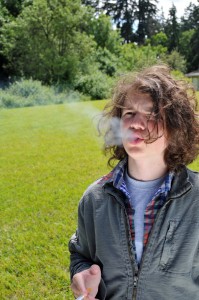
The relationship between cannabis and psychosis has been one of the hottest topics in psychiatry over the last decade, and with good reason. Policy-makers still disagree on whether cannabis should be legalised or how it should be classified, with Uruguay being the most recent country to legalise it.
Drawing broadly from work initiated by Robin Murray, at King’s College, links have been made between the use of cannabis and increased relative risk of developing psychosis (Arseneault et al, 2004), as well as decreased age of onset of psychosis (Large et al, 2011). What is sometimes forgotten is that a significant number of people smoking cannabis are concurrently exposed to another substance – nicotine. We know, clinically, that people with psychotic illness smoke more than the general population, though this has usually been ascribed to “self-medication”.
What if some of the increased risk of psychosis could be explained by cigarette smoking?
In this population study, taken from one of the best longitudinal datasets available (ALSPAC), Gage and colleagues sought to ascertain the relationship between smoking cigarettes, cannabis use and psychotic-like experiences (PEs) in a population survey.
Methods
The ALSPAC (Avon longitudinal study of Parents and Children) cohort is a population-based birth cohort study, and this study used data from 4,716 young people who completed the PLIKSi (Psychosis-like symptoms interview), a semi-structured questionnaire, at age 18.
Data on cannabis use and cigarette smoking was taken from self-report at age 16. Use of each substance was categorised, according to frequency:
- For cannabis
- Used 0 times
- 1–20 times
- 21–60 times
- More than 60 times
- For cigarettes:
- Non-smokers
- Experimenters
- Weekly smokers
- Daily smokers
- As well as a composite measure of use of both
A number of risk factors implicated in the aetiology of psychosis (such as family history of schizophrenia/depression, childhood adversity, urban dwelling, IQ and use of illicit substances) were also measured.
The authors then used ordinal logistic regression, looking at the relationship between various levels of exposure and experience of psychotic-like symptoms, adjusting for various risk factors, which may have confounded the relationship.

Study participants were asked about cannabis use and cigarette smoking at age 16
Results
In the total cohort, 97 people (5.5%) had incident suspected or definite PEs between ages 12 and 18.
Cannabis
- They found increased odds of PEs at age 18 in those who self-reported cannabis use at age 16, of 1.48 (95% CIs 1.18 to 1.86), meaning that there was a 48% increase in PEs per unit increase in cannabis use (i.e. there was a cumulative increase in odds)
- When they adjusted for confounders, and presence of symptoms whilst intoxicated with cannabis, this finding still existed
- Specifically adjusting for cigarette smoking frequency, brought this odds ratio down to 1.27.
Cigarette use
- They found increased odds of PEs at age 18 in those who self-reported cigarette use at age 16, of 1.61 per unit of cigarette use (95% CIs 1.31 to 1.98)
- This decreased to 1.53 when childhood risk factors were adjusted for
- When cannabis use was adjusted for, the OR decreased to 1.42
The authors were unable to examine the effects of cannabis alone (without nicotine), as only 3 people used cannabis in this fashion.
Strengths and limitations
A major strength of this study was the longitudinal design, and the use of measures that have valid psychometric properties;-the PLIKSi appears to be a lot more robust than other measures, like the CIDI, which tends to have a high false-positive rate, when compared to clinical interview (Jauhar et al, 2011).
The authors were able to control for confounders, which other studies have not been able to do, and also able to measure cannabis and cigarette use concurrently, and tease out the effects of cannabis on the increased risk associated with cigarette smoking (something very few other studies have done). They also measured use of cigarettes in a non-dichotomised fashion (i.e. smoker/non-smoker), picking up more subtle effects of use, in particular daily use, which would make more biological sense (daily use of nicotine being more indicative of nicotine dependence).
Limitations are those we tend to see in all large-scale epidemiological studies. All models tend to show associations, as opposed to clear causality, and assumptions made in modelling always tend to have arbitrary cut-offs.
Self-report measures, as the authors themselves point out, are not without their failings, though in a study such as this, it would have been difficult to obtain “direct” measures of use of cannabis and nicotine.
This study also shows that, by the very nature of the way people take cannabis, it is virtually impossible to exclude the effects of nicotine.
Conclusions
This study adds to recent work (Van Gastel et al, 2013), suggesting that psychotic-like experiences appear to be linked as much to cigarette use, as cannabis. In controlling for various confounders they have made the case that researchers will need to look more closely at the effects of cigarette smoking when evaluating risk of psychosis.
Pertinently, when looking at the risks associated with cannabis and psychosis, epidemiologists will need to account for the possible effects of cigarettes.
The intriguing question, which this study does pose, is whether smoking cigarettes could be implicated in the development of psychotic illness: a question that will no doubt be duly addressed by those in the field of psychosis research.

This new study shows that cigarette smoking may be implicated in the development of psychotic illness
Links
Gage SH, Hickman M, Heron J, Munafò MR, Lewis G, Macleod J and Zammit S. Associations of cannabis and cigarette use with psychotic experiences at age 18: findings from the Avon Longitudinal Study of Parents and Children. Psychological Medicine, available on CJO2014. doi:10.1017/S0033291714000531. [Abstract]
Arseneault L, Cannon M, Witton J, Murray RM. Causal association between cannabis and psychosis: examination of the evidence (PDF). Br J Psychiatry. 2004;184(2):110–7.
Large M, Sharma S, Compton MT, Slade T, Nielssen O. Cannabis use and earlier onset of psychosis: a systematic meta-analysis (PDF). Arch Gen Psychiatry. 2011;68(6):555.
Jauhar S, Lawrie SM. Are these results clinically relevant? BMJ. 2011;342.
Van Gastel WA, MacCabe JH, Schubart CD, Vreeker A, Tempelaar W, Kahn RS, et al. Cigarette smoking and cannabis use are equally strongly associated with psychotic-like experiences: a cross-sectional study in 1929 young adults. Psychol Med. 2013 Nov;43(11):2393–401. [PubMed abstract]


Cannabis, cigarette smoking and psychosis: do we need a rethink?: The relationship between cannabis and psycho… http://t.co/VpJBpI8LXO
@Mental_Elf So did the mental illness come first or smoking though? I know a big population of mentally ill people smoke. Chicken or egg?
Great article Sameer! Keep fighting the good fight
Cannabis, cigarette smoking and psychosis: do we need a rethink? http://t.co/HgEALigyrj via @sharethis
STUDY: Psychotic-like experiences appear to be linked as much to cigarette use, as #cannabis #breakthetaboo… http://t.co/FcJhKvD422
@Mental_Elf @sameerjauhar @BristolTARG @soozaphone interesting, thanks. Socioeconomic group +prodromal sx (?self-tx by smoking) confounders?
@PsychiatrySHO @Mental_Elf @sameerjauhar @BristolTARG included SES measures, & tried to exclude those already showing psychotic experiences
@soozaphone @Mental_Elf @sameerjauhar @BristolTARG thanks. Sounds robust! Got link to paper? Pinning down causation must be so tricky here
.@PsychiatrySHO @Mental_Elf @sameerjauhar @BristolTARG big problem is collinearity btwn can & cigs. Is paper linked in the blog?
@soozaphone @Mental_Elf @sameerjauhar and smoking and piles of other risk factors. And suggests coping w mental stress/prodrome etc…
@soozaphone @Mental_Elf @sameerjauhar @BristolTARG I don’t think there is a link, no.Would love to read paper, sounds like great bit of work
RT @MegEliz_: Today’s @Mental_Elf blog on cannabis, smoking&psychosis by @sameerjauhar is on research by @BristolTARG’s @soozaphone:http://…
Does smoking cigarettes cause some people to develop psychotic illness? Or is it the cannabis? http://t.co/TDnWK9XjAC By @Mental_Elf
Cannabis, cigarette smoking and psychosis: do we need a rethink? asks @sameerjauhar http://t.co/QL6DZRdQgz via @Mental_Elf
RT @soozaphone: Ooh, @Mental_Elf have blogged my recent research paper! Have a look! http://t.co/MCoxMvtKnO
“Cannabis, cigarette smoking and psychosis: do we need a rethink?” via @Mental_Elf http://t.co/tWIuLpeRWU
I personally attempted to raise this very issue with Dr Robin Murray and colleagues at the “Cannabis and mental health” conference he organised in 2004, the possibility was dismissed out of hand.
It is in fact a very easy hypothesis to explore. The link between cannabis and tobacco is a western European one, but cannabis users in the US generally do not mix the two.
However, this does raise an issue cannabis law reform campaigners have been trying to highlight for some time; the desirability of a safer use campaign aimed at cannabis users, discouraging the use of tobacco. Thus far the government have steadfastly refused to entertain such a concept.
New research suggests psychotic-like experiences may be linked as much to tobacco use as cannabis | via @Mental_Elf http://t.co/IQd7fDLuG8
@GeorgeTransform @malkythompson @Mental_Elf No shit – if Cartels didn’t run research U’d know that it’s from Nutrient Depl., Toxicity & Ph.
@Mental_Elf i done an essay using research on the relationship between cannabis and pshychosis
@Mental_Elf the results did show a relationship but emphasised that socio-economic and other factors are a bigger influence
Zigaretten: gleiches Risiko für Psychose wie Cannabis? http://t.co/Mqfu4tVq64
Mental Elf: Cannabis, cigarette smoking and psychosis: do we need a rethink? http://t.co/xr4b7ATafj
@vocnederland This new study shows that cigarette smoking may implicate the development of psychotic illness http://t.co/ZdO7xuaM7I
Could smoking cigarettes be implicated in the development of psychotic illness?Do we need a tobacco/cannabis rethink? http://t.co/nT7eHYeuSL
@sameerjauhar writes his debut blog on the associations of cannabis & cigarette use w/ psychotic experiences aged 18 http://t.co/jTVV8jzYnC
RT @DoctorChristian: Cannabis use and psychosis -perhaps we should worry more about tobacco…: http://t.co/ooYm8akclz
@Mental_Elf interesting read
We’ve had a great response to our blog on #cannabis, cigarette #smoking & #psychosis. Pls let us know yr thoughts http://t.co/jTVV8jzYnC
Join in the discussion about cannabis, tobacco and psychosis on our blog. This new research suggests that psychotic-like experiences may be linked as much to tobacco use as cannabis: http://www.thementalelf.net/mental-health-conditions/substance-misuse/cannabis-cigarette-smoking-and-psychosis-do-we-need-a-rethink/
Cannabis, cigarette smoking and psychosis: do we need a rethink? http://t.co/Qn98loLtfW @Mental_Elf
“@Mental_Elf: Cannabis, cigarette smoking & psychosis: do we need a rethink? http://t.co/lijyDIe4Wu” Are cigarettes implicated in psychosis?
#Cannabis, cigarette smoking and psychosis: do we need a rethink? See what one researcher says… #science
http://t.co/KZNAcCQyDb
RT @LondonCannabis: Cannabis use and psychosis -perhaps we should worry more about tobacco…
Smoke pure peeps!
Orson http://t.co/LYnV6Kp…
New longitudinal study shows that cigarette smoking may be implicated in the development of psychotic illness http://t.co/jTVV8jzYnC
Don’t miss: Cannabis, cigarette smoking and psychosis: do we need a rethink? http://t.co/jTVV8jzYnC
RT @Mental_Elf: Study using ALSPAC data finds that psychotic experiences at age 18 are linked to both cannabis use AND tobacco use http://t…
Cannabis, cigarette smoking and psychosis: do we need a rethink? Interesting research from ALSPAC data http://t.co/sh7H9rNby2
RT @profhrs: Nice summary of Gage et al looking at psychotic symptomatology, cannabis, and tobacco http://t.co/eOyvLB4pPc
#Cannabis, #cigarette #smoking and #psychosis: Do we need a rethink? http://t.co/bDNx3KjByb
#Cannabis, cigarette smoking and #psychosis: do we need a rethink?http://t.co/wiV6yPSizD
RT @Release_drugs: #Cannabis, cigarette smoking and psychosis: do we need a rethink? See what one researcher says:
http://t.co/PMTOvxzz5Q
A very interesting read.
http://t.co/1vQtZ08ujc
RT @Mental_Elf: A great debut blog today from @sameerjauhar on cannabis, smoking & psychosis: http://t.co/jTVV8jzYnC Welcome to the woodlan…
Most popular blog this week? @sameerjauhar Cannabis, cigarette smoking & psychosis: do we need a rethink? http://t.co/jTVV8jzYnC
Interesting summary from @Mental_Elf does cigarette smoking induce psychosis similarly to canabis use? http://t.co/0WgJ3QRd1g
Our most popular blog ever? This one’s coming close: Cannabis, cigarette smoking & psychosis: do we need a rethink? http://t.co/jTVV8jzYnC
Really interesting article suggesting that smoking cigarettes is just as likely to cause psychosis as cannabis.
http://t.co/YTYUCi2e5R
A useful approach in this analyses might have been to collapse the cig smoking and cannabis smoking into 2 binary variables (cig smoker / non-smoker — and —cannabis smoker / cannabis non-smoker) and to evaluate this in a statistical interaction term included in the logistic regression model on PE but only if numbers allowed.
Raza
should look up Terrance McKenna the invisible landscape there some interesting ideas that needs looked at, its well documented in Holland that T.H.C. is the main component in psychosis BUT it is also noted that C.B.D. is the balancing factor, for this to be used as a method of study in comparison to the side effects of prescribed drugs, willing control studies need to be undertaken in this field, self medicating cannabis user of more than 25 years, with an outstanding education
[…] research which shows that cannabis use is associated with a variety of negative outcomes, e.g. psychotic experiences at age 18. This new study adds to our knowledge, but what can we really take […]
In my extensive experience of working with users of mental health services the reasons for diagnosed psychosis have always been rooted in their life experiences, and the consequent feelings, thoughts and actions these experiences have generated. Smoking cannabis and/or cigarettes have always been the result of acquired social habits, and smoking cigarettes was often a consequence of hospitalisation.
[…] S. Cannabis, cigarette smoking and psychosis: do we need a rethink? The Mental Elf, 14 May […]
[…] Cannabis, cigarette smoking and psychosis: do we need a rethink? […]